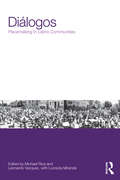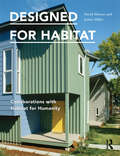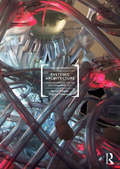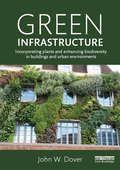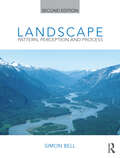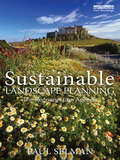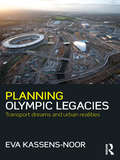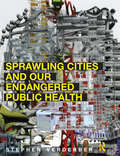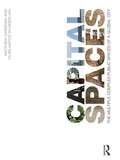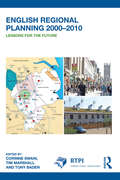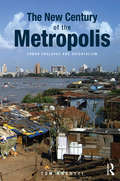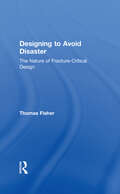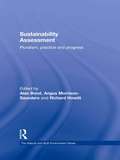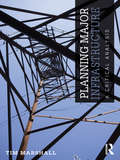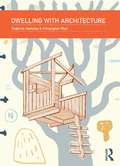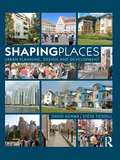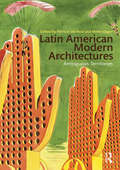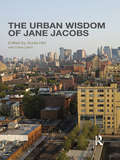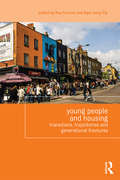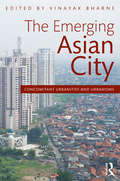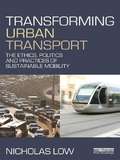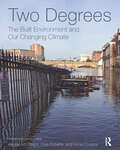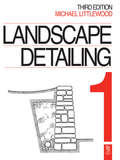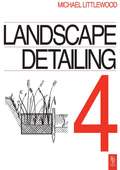- Table View
- List View
Diálogos: Placemaking in Latino Communities
by Michael Rios Leonardo Vazquez Lucrezia MirandaLatinos are one of the largest and fastest growing social groups in the United States, and their increased presence is profoundly shaping the character of urban, suburban, and rural places. This is a response to these developments and is the first book written for readers seeking to learn about, engage and plan with Latino communities. It considers how placemaking in marginalized communities sheds light on, and can inform, community-building practices of professionals and place dwellers alike. Diálogos: Placemaking in Latino Communities will help readers better understand the conflicts and challenges inherent in placemaking, and to make effective and sustainable choices for practice in an increasingly multi-ethnic world. The essays explore three aspects of place: the appropriation and territorialization of the built environment, the claiming of rights through collective action, and a sense of belonging through civic participation. The authors illustrate their ideas through case studies and explain the implications of their work for placemaking practice. A consistent theme about planning and design practice in Latino communities emerges throughout the book: placemaking happens with or without professional planners and designers. All of the essays in Diálogos demonstrate the need to not only imagine, build, and make places with local communities, but also to re-imagine how we practice democracy inclusive of cross-cultural exchange, understanding, and respect. This will require educators, students, and working professionals to incorporate the knowledge and skills of cultural competency into their everyday practices.
Designed for Habitat: Collaborations with Habitat for Humanity
by David Hinson Justin MillerIf you're looking for ways to give back to your community, then this book, the first to profile thirteen projects designed and built by architects and Habitat for Humanity, will help. Detailed plans, sections, and photographs show you how these projects came about, the strategies used by each team to approach the design and construction process, and the obstacles they overcame to realize a successful outcome. The lessons and insights, presented here will aid you, whether you're an architect, architecture student, Habitat affiliate leader, or an affordable housing advocate. Located all across the United States, these projects represent the full spectrum of Habitat for Humanity affiliates, from large urban affiliates to small rural programs. These cases illustrate a broad range of innovative approaches to energy performance, alternative construction strategies, and responses to site context. And each house demonstrates that design quality need not fall victim to the rigorous imperatives of cost, delivery, and financing.
Systemic Architecture: Operating Manual for the Self-Organizing City
by Marco Poletto Claudia PasqueroThis is a manual investigating the subject of urban ecology and systemic development from the perspective of architectural design. It sets out to explore two main goals: to discuss the contemporary relevance of a systemic practice to architectural design, and to share a toolbox of informational design protocols developed to describe the city as a territory of self-organization. Collecting together nearly a decade of design experiments by the authors and their practice, ecoLogicStudio, the book discusses key disciplinary definitions such as ecologic urbanism, algorithmic architecture, bottom-up or tactical design, behavioural space and the boundary of the natural and the artificial realms within the city and architecture. A new kind of "real-time world-city" is illustrated in the form of an operational design manual for the assemblage of proto-architectures, the incubation of proto-gardens and the coding of proto-interfaces. These prototypes of machinic architecture materialize as synthetic hybrids embedded with biological life (proto-gardens), computational power, behavioural responsiveness (cyber-gardens), spatial articulation (coMachines and fibrous structures), remote sensing (FUNclouds), and communication capabilities (Ecological Footprint Grotto). Supporting the authors’ own essays and projects are contributions from key innovators in contemporary architecture and urban design: Michael Batty, Andrew Hudson-Smith, Michael Weinstock and Patrik Schumacher.
Green Infrastructure: Incorporating Plants and Enhancing Biodiversity in Buildings and Urban Environments (Routledge Studies in Urban Ecology)
by John W. DoverWith more than half of the world's population now living in urban areas, it is vitally important that towns and cities are healthy places to live. The principal aim of this book is to synthesize the disparate literature on the use of vegetation in the built environment and its multifunctional benefits to humans. The author reviews issues such as: contact with wildlife and its immediate and long-term effects on psychological and physical wellbeing; the role of vegetation in removing health-damaging pollutants from the air; green roofs and green walls, which provide insulation, reduce energy use and decrease the carbon footprint of buildings; and structural vegetation such as street trees, providing shading and air circulation whilst also helping to stop flash-floods through surface drainage. Examples are used throughout to illustrate the practical use of vegetation to improve the urban environment and deliver ecosystem services. Whilst the underlying theme is the value of biodiversity, the emphasis is less on existing high-value green spaces (such as nature reserves, parks and gardens), than on the sealed surfaces of urban areas (building surfaces, roads, car parks, plazas, etc.). The book shows how these, and the spaces they encapsulate, can be modified to meet current and future environmental challenges including climate change. The value of existing green space is also covered to provide a comprehensive textbook of international relevance.
Landscape: Pattern, Perception and Process
by Simon BellLandscapes develop and evolve through an interacting series of processes – climatic, geological, ecological and cultural – over varying periods of time. These processes shape the structure and character of the landscapes which we experience. Over time, distinctive patterns emerge – ranging in scale from the distribution of small plants to the sculptured sides of a huge canyon. Our perception of these patterns goes beyond just their visual appreciation – beautiful though they may be – into a richer understanding of how we experience our environment. By understanding this complex pattern–process interaction we can obtain a deeper awareness of landscape and our place in it – as inhabitants and as shapers. The book explores the nature of patterns and ways of classifying them before studying the nature of perception (primarily visual but including other senses), then proceeds to relate this perception to aesthetics and from there to the design process. From this point the main driving processes in landscape are introduced alongside the resulting patterns, these being climatic, landform, ecosystem and cultural aspects. It is this integrative approach of looking at landscape as a kind of self-organising system, overlaid by conscious human planning activities and the unity of pattern and process, which makes this book unique. Landscape draws from a wide range of neighbouring disciplines, of which the landscape planner or designer needs to be aware, but which are often taught as distinct elements. Bell binds these fundamentals together, which enables the landscape to be ‘read’, and this reading to be used as the basis for planning and design. This second edition updates and refreshes the original material with added sections and new photos, particularly making use of the developments in satellite photography. Featuring full colour throughout, this textbook is ideal for anyone studying landscape architecture or any of the disciplines which intersect with the landscape, and which affect it.
Sustainable Landscape Planning: The Reconnection Agenda
by Paul SelmanThis book takes as its starting point the need to examine critically the case for landscape reconnection. It looks at alleged disconnections and their supposed consequences. It explores the arguments about reconnecting the natural and human elements of whole landscapes. More broadly, it considers landscape as an arena within which science, humanities and professions can find common ground, and in which vivid social learning can occur about key social and environmental issues. It takes a dynamic view of landscape, in contrast to the popular image of timeless, traditional scenery. It accepts that even the most cherished cultural landscapes will change and, indeed, it views 'change drivers' as a potentially positive means of creating new connectivities between people and place. It recognises the growing interest in promoting resilience and ecosystem services across extensive landscapes - such as by creating new 'space' for water and wildlife.
Planning Olympic Legacies: Transport Dreams and Urban Realities
by Eva Kassens-NoorWhen a city wins the right to hold the Olympics, one of the oft cited advantages to the region is the catalytic effect upon the urban and transport projects of the host cities. However, with unparalleled access to documents and records, Eva Kassens-Noor questions and challenges this fundamental assertion of host cities who claim to have used the Olympic Games as a way to move forward their urban agendas In fact, transport dreams to stage the "perfect games" of the International Olympic Committee and the governments of the host cities have lead to urban realities that significantly differ from the development path the city had set out to accomplish before winning the Olympic bid. Ultimately it is precisely the IOC’s influence – and the city’s foresight and sophistication (or lack thereof) in coping with it – that determines whether years after the Games there are legacies benefitting the former hosts. The text is supported by revealing interviews from lead host city planners and key documents, which highlight striking discrepancies between media broadcasts and the internal communications between the IOC and host city governments. It focuses on the inside story of the urban and transport change process undergone by four cities (Barcelona, Atlanta, Sydney, and Athens) that staged the Olympics and forecasts London and Rio de Janeiro’s urban trajectories. The final chapter advises cities on how to leverage the Olympic opportunity to advance their long-run urban strategic plans and interests while fulfilling the International Olympic Committee’s fundamental requirements. This is a uniquely positioned look at why Olympic cities have – or do not have – the transport and urban legacies they had wished for. The book will be of interest to planners, government agencies and those involved in organizing future Games.
Sprawling Cities and Our Endangered Public Health
by Stephen VerderberSprawl is an unsustainable pattern of growth that threatens to undermine the health of communities globally. It has been a dominant mid-to-late twentieth century growth pattern in developed countries and in the twenty-first century has shown widespread signs of proliferation in India, China, and other growing countries. The World Health Organization cites sprawl for its serious adverse public health consequences for humans and ecological habitats. The many adverse impacts of sprawl on the health of individuals, communities, and biological ecosystems are well documented. Architects have been rightly criticized for failing to grasp the aesthetic and functional challenge to create buildings and places that mitigate sprawl while simultaneously promoting healthier, active lifestyles in neighbourhoods and communities. Sprawling Cities and Our Endangered Public Health examines the past and present role of architecture in relation to the public health consequences of unmitigated sprawl and the ways in which it threatens our future. Topics examined include the role of twentieth century theories of architecture and urbanism and their public health ramifications, examples of current unsustainable practices, design considerations for the creation of health-promoting architecture and landscape urbanism, a critique of recent case studies of sustainable alternatives to unchecked sprawl, and prognostications for the future. Architects, public health professionals, landscape architects, town planners, and a broad range of policy specialists will be able to apply the methods and tools presented here to counter unmitigated sprawl and to create architecture that promotes active, healthier lifestyles. Stephen Verderber is an internationally respected evidence-based researcher/practitioner/educator in the emerging, interdisciplinary field of architecture, health, and society. This, his latest book on the interactions between our buildings, our cities and our health, is an invaluable reference source for everyone concerned with sustainable architecture and landscape urbanism.
Capital Spaces: The Multiple Complex Public Spaces of a Global City
by Matthew Carmona Filipa Matos WunderlichIn recent years it has become common-place to hear claims that public space in cities across the globe has become the exclusive preserve of the wealthy and privileged, at the expense of the needs of wider society. Whether it is the privatization of public space through commerical developments like shopping malls and business parks, the gentrification of existing spaces by campaigns against perceived anti-social behaviour or the increasing domination of public areas by private transport in the form of the car, the urban public space is seen as under threat. But are things really that bad? Has the market really become the sole factor that influences the treatment of public space? Have the financial and personal interests of the few really come to dominate those of the many? To answer these questions Matthew Carmona and Filipa Wunderlich have carried out a detailed investigation of the modern public spaces of London, that most global of cities. They have developed a new typology of public spaces applicable to all cities, a typology that demonstrates that to properly assess contemporary urban places means challenging the over-simplification of current critiques. Global cities are made up of many overlapping public spaces, good and bad; this book shows how to analyze this complexity, and to understand it.
English Regional Planning 2000-2010: Lessons for the Future (RTPI Library Series)
by Tim Marshall Corinne Swain Tony BadenEnglish Regional Planning 2000-2010 chronicles a vital feature of recent UK planning activity, during the period of the Blair and Brown Labour governments up to 2010. It deals particularly with the regional scale of planning during these years, whereby large steps forward were made, but where policy making often proved very controversial. One purpose of the book is to learn from the many areas of policy development, method and skills which evolved during the decade up to 2010. This will mean that a future return to strategic planning should not have to reinvent the wheel. This book also helps to inform such planning in the rest of the developed world where higher-level planning is more prevalent. The book has eight chapters written by experts active in English regional planning during these years, alongside two chapters by the editors introducing and concluding on the experience as a whole. Thematic topics covered include the way in which housing and employment development was tackled in the varying English regional contexts, and the growing influence of transport and environmental factors on the spatial strategy. Process elements covered include how policy was made through public consultation and working with numerous stakeholders (economic, social, environmental), how the public examination of issues was organised, followed by final consideration by central government, and how monitoring informed the next policy review. The authors do not gloss over the difficulties encountered in the highly contested world of English local and regional politics, or the ways in which central government management of the regional planning process made life on the ground difficult for those engaged in the process. Nevertheless the account as a whole shows how a wealth of innovative and forward looking practices were developed. This multi-faceted study contributes to the understanding of how strategic planning can provide the framework for guiding spatial change and allocating resources, looking to a long-term sustainable future.
The New Century of the Metropolis: Urban Enclaves and Orientalism
by Tom AngottiThe problems created by metropolitanization have become increasingly apparent. Attempts to limit growth, disperse populations and plan neighbourhoods have been largely unsuccessful. Strategies are needed to improve the world's major cities in the twenty-first century. Tom Angotti is fundamentally optimistic about the future of the metropolis, but questions urban planning’s inability to integrate urban and rural systems, its contribution to the growth of inequality, and increasing enclave development throughout the world. Using the concept of 'urban orientalism' as a theoretical underpinning of modern urban planning grounded in global inequalities, Angotti confronts this traditional model with new, progressive approaches to community and metropolis. Written in clear, precise terms by an award-winning author, The New Century of the Metropolis argues that only when the city is understood as a necessary and beneficial acccompaniment to social progress can a progressive, humane approach to urban planning be developed.
Designing To Avoid Disaster: The Nature of Fracture-Critical Design
by Thomas FisherRecent catastrophic events, such as the I-35W bridge collapse, New Orleans flooding, the BP oil spill, Port au Prince's destruction by earthquake, Fukushima nuclear plant's devastation by tsunami, the Wall Street investment bank failures, and the housing foreclosure epidemic and the collapse of housing prices, all stem from what author Thomas Fisher calls fracture-critical design. This is design in which structures and systems have so little redundancy and so much interconnectedness and misguided efficiency that they fail completely if any one part does not perform as intended. If we, as architects, planners, engineers, and citizens are to predict and prepare for the next disaster, we need to recognize this error in our thinking and to understand how design thinking provides us with a way to anticipate unintended failures and increase the resiliency of the world in which we live. In Designing to Avoid Disaster, the author discusses the context and cultural assumptions that have led to a number of disasters worldwide, describing the nature of fracture-critical design and why it has become so prevalent. He traces the impact of fracture-critical thinking on everything from our economy and politics to our educational and infrastructure systems to the communities, buildings, and products we inhabit and use everyday. And he shows how the natural environment and human population itself have both begun to move on a path toward a fracture-critical collapse that we need to do everything possible to avoid. We designed our way to such disasters and we can design our way out of them, with a number of possible solutions that Fisher provides.
Sustainability Assessment: Pluralism, practice and progress (Natural and Built Environment Series)
by Alan Bond Angus Morrison-Saunders Richard HowittSustainability Assessment is an increasingly important tool for informing planning and development decisions across the globe. Required by law in some countries, strongly recommended in others, a comprehensive analysis of why Sustainability Assessment is needed and clarification of the value-laden and political nature of assessments is long overdue. Currently the writing on the subject is limited and comprises, for the most part, guidance documents and completed assessments. This book overcomes these shortcomings by simultaneously providing the knowledge, inspiration and range of assessment tools in decision-making students require to tackle Sustainability Assessment challenges nested within wide-ranging values and sustainability-grounded evidence. The collection details the current state-of-the art in relation to Sustainability Assessment theory and practice, and considers the pluralistic nature of the tool and the implications for achieving sustainable decision-making. The contributors set out the context for Sustainability Assessment and then outline some contested issues which can affect interpretations of whether the decision tool has been effective. Current practice worldwide is assessed against a consistent framework and then solutions to some of the inherent weaknesses and causes of conflict in relation to the perceived sustainability of outcomes are put forward. The book is unique in setting out state-of-the-art in terms of Sustainability Assessment practice by focusing on those countries with developing experience. It also covers emerging factors influencing effectiveness of decision-making tools and evaluates how they affect the performance of Sustainability Assessment. Written by authors among the leading university academics teaching impact assessment courses in the most acclaimed universities worldwide operating in this field, it is ideally suited for the growing numbers of courses in impact assessment education and training.
Planning Major Infrastructure: A Critical Analysis
by Tim MarshallThis book analyses the planning and policy world of major infrastructure as it is moving now in Europe and the UK. Have some countries managed to generate genuine consensus on how the large changes are progressed? What can we learn from the different ways countries manage these challenges, to inform better spatial planning and more intelligent political steering? Case studies of the key features of policy and planning approaches in France, Germany, the Netherlands, Spain and the UK are at the core of Planning Major Infrastructure. This includes the different regimes introduced in England and Wales, and Scotland, brought in by reforms since 2006. High speed rail, renewable energy deployment, water management, waste treatment – all raise critical planning issues. The case studies connect to the big issues of principle which haunt this field of public policy: how can democratic legitimacy be secured? How can ecological and economic transitions be managed? What is the appropriate role of the national government in each of these areas, as against other levels? What part has the EU played, and should it be involved in the future? These are some of the central themes raised in this innovating exploration of this currently high profile field.
Dwelling with Architecture
by Roderick Kemsley Christopher PlattThe dwelling is the most fundamental building type, nowhere more so than in the open landscape. This book can be read in a number of ways. It is first a book about houses and particularly the theme ‘dwelling and the land’. It examines the poetic and prosaic issues inherent in claiming a piece of the landscape to live on. It could also be seen as a kind of road map, full of both warnings and encouragements for all those involved with, or just interested in, the making of houses. That the domestic realm and the landscape can be vehicles for significant architectural insights is hardly an original observation. However this book seeks to bring the two topics together in a unique way. In exploring a building type that lies on the cusp of what is commonly understood as ‘building’ and ‘architecture’, it asks fundamental questions about what the very nature of architecture is. Who indeed is the architect and what is their role in the process of creating meaningful buildings?
Shaping Places: Urban Planning, Design and Development
by David Adams Steve TiesdellShaping Places explains how towns and cities can turn real estate development to their advantage to create the kind of places where people want to live, work, relax and invest. It contends that the production of quality places which enhance economic prosperity, social cohesion and environmental sustainability require a transformation of market outcomes. The core of the book explores why this is essential, and how it can be delivered, by linking a clear vision for the future with the necessary means to achieve it. Crucially, the book argues that public authorities should seek to shape, regulate and stimulate real estate development so that developers, landowners and funders see real benefit in creating better places. Key to this is seeing planners as market actors, whose potential to shape the built environment depends on their capacity to understand and transform the embedded attitudes and practices of other market actors. This requires planners to be skilled in understanding the political economy of real estate development and successful in changing its outcomes through smart intervention. Drawing on a strong theoretical framework, the book reveals how the future of places will come to be shaped through constant interaction between State and market power. Filled with international examples, essential case studies, color diagrams and photographs, this is essential reading for undergraduate and graduate students taking planning, property, real estate or urban design courses as well as for social science students more widely who wish to know how the shaping of place really occurs.
Latin American Modern Architectures: Ambiguous Territories
by Patricio Del Real Helen GygerLatin American Modern Architectures: Ambiguous Territories has thirteen new essays from a range of distinguished architectural historians to help you understand the region’s rich and varied architecture. It will also introduce you to major projects that have not been written about in English. A foreword by historian Kenneth Frampton sets the stage for essays on well-known architects, such as Lucio Costa and Félix Candela, which will show you unfamiliar aspects of their work, and for essays on the work of little-known figures, such as Uruguayan architect Carlos Gómez Gavazzo and Peruvian architect and politician Fernando Belaúnde Terry. Covering urban and territorial histories from the nineteenth and twentieth centuries, along with detailed building analyses, this book is your best source for historical and critical essays on a sampling of Latin America's diverse architecture, providing much-needed information on key case studies. Contributors include Noemí Adagio, Pedro Ignacio Alonso, Luis Castañeda, Viviana d’Auria, George F. Flaherty, María González Pendás, Cristina López Uribe, Hugo Mondragón López, Jorge Nudelman Blejwas, Hugo Palmarola Sagredo, Gaia Piccarolo, Claudia Shmidt, Daniel Talesnik, and Paulo Tavares.
The Urban Wisdom of Jane Jacobs (Planning, History and Environment Series)
by Sonia Hirt Diane ZahmHere for the first time is a thoroughly interdisciplinary and international examination of Jane Jacobs’s legacy. Divided into four parts: I. Jacobs, Urban Philosopher; II. Jacobs, Urban Economist; II. Jacobs, Urban Sociologist; and IV. Jacobs, Urban Designer, the book evaluates the impact of Jacobs’s writings and activism on the city, the professions dedicated to city-building and, more generally, on human thought. Together, the editors and contributors highlight the notion that Jacobs’s influence goes beyond planning to philosophy, economics, sociology and design. They set out to answer such questions as: What explains Jacobs’s lasting appeal and is it justified? Where was she right and where was she wrong? What were the most important themes she addressed? And, although Jacobs was best known for her work on cities, is it correct to say that she was a much broader thinker, a philosopher, and that the key to her lasting legacy is precisely her exceptional breadth of thought?
Young People and Housing: Transitions, Trajectories and Generational Fractures (Housing and Society Series)
by Ray Forrest Ngai Ming YipYoung People and Housing brings together new research exploring the economic, social, and cultural challenges that face young people in search of permanent housing. Featuring international case studies from Asia, Europe, and Australia, Young People and Housing is a collection of groundbreaking work from leading scholars in housing policy. Younger generations across a wide range of societies face increasing difficulties in gaining access to housing. Housing occupies a pivotal position in the transition from parental dependence to adult independence. Delayed independence has significant implications for marriage and family formation, fertility, inter and intra generational tensions, social mobility and social inequalities. The social and cultural dimensions are, of course, enormously varied with strong contrasts between Asian and Western societies in terms of intergenerational norms and practices in relation to housing. Nevertheless, younger households in China (including Hong Kong), Japan, the USA, Australasia and Europe face very similar challenges in the housing sphere. Moreover, concerns about the housing future for younger generations are gaining greater policy and popular prominence in many countries.
The Emerging Asian City: Concomitant Urbanities & Urbanisms
by Vinayak BharneThe Asian urban landscape contains nearly half of the planet’s inhabitants and more than half of its slum population living in some of its oldest and densest cities. It encompasses some of the world’s oldest civilizations and colonizations, and today contains some of the world’s fastest growing cities and economies. As such Asian cities create concomitant imagery – polarizations of poverty and wealth, blurred lines between formality and informality, and stark juxtapositions of ancient historic places with shimmering new skylines. This book embraces the complexity and ambiguity of the Asian urban landscape, and surveys its bewildering array of multifarious urbanities and urbanisms. Twenty-four essays offer scholarly reflections and positions on the complex forces and issues shaping Asian cities today, looking at why Asian cities are different from the West and whether they are treading a different path to their futures. Their combined narrative – spanning from Turkey to Japan and Mongolia to Indonesia - is framed around three sections: Traditions reflects on indigenous urbanisms and historic places, Tensions reflects on the legacies of Asia’s East–West dialectic through both colonialism and modernism and Transformations examines Asia’s new emerging utopias and urban aspirations. The book claims that the histories and destinies of cities across various parts of Asia are far too enmeshed to unpack or oversimplify. Avoiding the categorization of Asian cities exclusively by geographic location (south-east, Middle East), or the convenient tagging of the term Asian on selective regional parts of the continent, it takes a broad intellectual view of the Asian urban landscape as a 'both…and' phenomenon; as a series of diverse confluences – geographic, historic and political – extending from the deserts of the Persian Gulf region to the Pearl River Delta. Arguing for Asian cities to be taken seriously on their own terms, this book represents Asia – as a fount of extraordinary knowledge that can challenge our fundamental preconceptions of what cities are and ought to be.
Transforming Urban Transport: From Automobility to Sustainable Transport
by Nicholas LowTransforming Urban Transport confronts head-on the dilemma faced by a world wedded to mobility: the danger of continuing along the fossil-fuelled path and the real paucity of viable technological alternatives which can be deployed in time. To respond to the dilemma, the ideal of urban transport must be changed from auto-based mobility to systems of sustainable transport in which public transport, and non-motorised transport work together to reduce climate change pressures, enhance urban quality and preserve life and health. The book challenges the commonly held view that a combination of urbanity and higher residential density expressed in compact cities (expected to have greater public transport use) will resolve urban transport/environment problems, instead showing that transport systems can be changed to meet the environmental imperatives without the massive spatial change implied. But the problem of change of urban transport is profoundly institutional and cultural. Changes in urban mobility and transport require local institutional policy action. To support such action, the book explores new methods of governance of transport in dispersed and concentrated cities, new techniques for assessing transport need, ways of improving childhood mobility, guidelines for political mobilization, and norms of knowledge sharing. Drawing together leading scholars from different disciplines in Australia, Japan and China, this book provides a unique fusion of Asian and Australasian perspectives and engages with the coming needs of transport planning practitioners in both high density and dispersed cities.
Two Degrees: The Built Environment And Our Changing Climate
by Alisdair McGregor Cole Roberts Fiona CousinsThe Earth’s temperature has been rising. To limit catastrophic outcomes, the international scientific community has set a challenging goal of no more than two degrees Celsius (3.6 degrees Fahrenheit) average temperature rise. Economists agree we will save trillions of dollars by acting early. But how do we act successfully? And what’s the backup plan if we fall short? Setting politics aside, Two Degrees reviews the current science and explains how we can set practical steps to reduce the extent of warming and to adapt to the inevitable changes, all while improving the bottom line, beautifying our communities, and increasing human health. The book is a practical guide intended for a broad audience of those who occupy and shape our built environment. The authors provide a clear framework for communities, policy makers, planners, designers, developers, builders, and operators to help manage the impacts and capture the opportunities of our changing climate. Two Degrees is divided into three sections—Fundamentals, Mitigation, and Adaptation—covering a diverse array of topics ranging from climate-positive communities and low-carbon buildings to the psychology of choice and the cost of a low-carbon economy. After a foreword by Amory Lovins, more than 10 contributing authors share knowledge based on direct experience in all aspects of built environment practice. This book clarifies the misconceptions, provides new and unique insights, and shows how a better approach to the built environment can increase resilience and positively shape our future.
The Urban Section: An analytical tool for cities and streets
by Robert ManthoThe design of streets, and the connections between streets of different character, is the most important task for architects and urbanists working in an urban context. Considered at two distinct spatial scales – that of the individual street – the Street Section – and the complex of city streets – the City Transect – Urban Section identifies a range of generic street types and their success or otherwise in responding to climatic, cultural, traditional, morphological, social and economic well being. Using comparative studies a profile of best practice in street and city design is identified, showing methodologies in both the analysis of, and design for, successful streets and public places – place-making. In uniquely dealing with both the historic and contemporary description and analysis of urban ‘streets’ around the world, the work is of both academic and professional interest to architects, urban planners and designers, highway engineers, landscape and urban design advisers in both the public and private sectors; students, amenity and civic societies, city authorities and government agencies.
Landscape Detailing Volume 1: Enclosures
by Michael LittlewoodMichael Littlewood's Landscape Detailing is now well established as a valuable source of reference for architects, landscape architects, other professionals and students designing external works.Volume I, Enclosures, covers walls (free-standing, screen and retaining), fences, gates, barriers and bollards. Each section begins with technical guidance notes on design and construction and then provides a list of points against which specifications can be checked. This is followed by a set of drawn-to-scale detail sheets. These details can be traced for direct incorporation into the set of contract drawings. A list of relevant British Standards, references, bibliography and a list of associations and institutions indicate where further guidance can be obtained. As a ready reference for landscape designers and as an indispensable time-saving tool, Landscape Detailing is an essential for the design office.
Landscape Detailing Volume 4: Enclosures
by Michael LittlewoodWell established as a valuable source of reference for architects, landscape architects, professionals and students designin external works. This volume covers water features and offers drawings detailed to scale, unlike many of the other books on the market which only deal in sketch forms.Covers landscape ponds, streams and waterfalls, fountains, edges, bank protection, revetments, dams, weirs and sluices, island rafts and jetties and drainage. Each section begins with technical guidance notes on design and construction. This is followed by a set of drawn-to-scale detail sheets. These details can be traced for direct incorporation into the set of contract drawings. A ready reference for landscape designers and an indispensable time-saving tool, Landscape Detailing is an essential for the design office.
